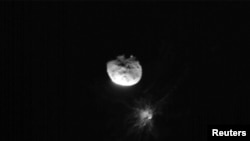In the moments before NASA's DART spacecraft slammed into the asteroid Dimorphos in a landmark planetary defense test in 2022, it took high-resolution images of this small celestial object and its larger companion Didymos.
These images have enabled scientists to unravel the complicated history of these two rocky bodies located in the vicinity of Earth and gain insight into the formation of what are called binary asteroid systems — a primary asteroid with a secondary moonlet orbiting it.
An analysis of the craters and surface strength on Didymos indicated it formed about 12.5 million years ago. A similar analysis indicated Dimorphos formed about 300,000 years ago. Didymos probably formed in our solar system's main asteroid belt, between the planets Mars and Jupiter, and then was knocked into the inner solar system, the researchers said.
An examination of the largest boulders on Didymos and Dimorphos gave clues about the origins of the two asteroids.
"Both asteroids are aggregates of rocky fragments formed from the catastrophic destruction of a parent asteroid," said astronomer Maurizio Pajola of the National Institute for Astrophysics (INAF) in Italy, lead author of one of five studies on the asteroids published on Tuesday in the journal Nature Communications.
"These large boulders could not have formed from impacts on the surfaces of Didymos and Dimorphos themselves, as such impacts would have disintegrated these bodies," Pajola added.
Didymos, which has a diameter of about a half mile (780 meters), is classified as a near-Earth asteroid. Dimorphos is roughly 560 feet (170 meters) wide. Both are "rubble pile" asteroids, composed of pieces of rocky debris that coalesced through the influence of gravity.
"Their surface is covered with boulders. The largest on Dimorphos is the size of the school bus, while the largest on Didymos is big as soccer field," said Olivier Barnouin, a planetary geologist and geophysicist at the Johns Hopkins University Applied Physics Laboratory in Maryland and lead author of another of the studies.
"There are cracks on the surface and the rocks of Dimorphos, while Didymos may have finer-grained soils at the equator, although it is difficult to be sure with the images we have. The surfaces of both asteroids are weak, much weaker than loose sand," Barnouin added.
The researchers concluded that Dimorphos is composed of material that flew off the equatorial region of Didymos due to the speed at which it was spinning.
"In the case of Didymos, it is thought that in the past, it rotated faster around its axis due to the YORP effect (spin acceleration driven by the effect of sunlight on its uneven surface), and thus ejected the boulders from its equatorial region, forming Dimorphos," Pajola added.
Didymos currently spins at a rate of once every 2-1/4 hours.
Few boulders were observed at the equatorial region of Didymos.
"Its equator is much smoother, while mid-latitudes up to the poles are much rougher, with big boulders sitting on the surface," Pajola said.
The U.S. space agency's DART (Double Asteroid Redirection Test) carried out a proof-of-principle mission, demonstrating that a spacecraft could apply kinetic force to change the path of a space object that otherwise might be on a collision course with Earth. Didymos and Dimorphos do not pose an actual threat to Earth.
DART struck Dimorphos on Sept. 26, 2022, at about 14,000 miles per hour (22,530 kph) at a distance of roughly 6.8 million miles (11 million km) from Earth, and succeeded in modestly changing its path. The collision also slightly changed the shape of Dimorphos.
The DART data has improved the understanding of binary asteroid systems.
"Binary asteroid systems represent about 10-15% of the total number of asteroids that are in near-Earth space," Barnouin said. "More generally, with every new observation of an asteroid or asteroid system, we learn more about how asteroids form and evolve. They are complex systems, but have some key similarities, especially when we consider the smaller — less than a kilometer (0.62 mile) — asteroids."










